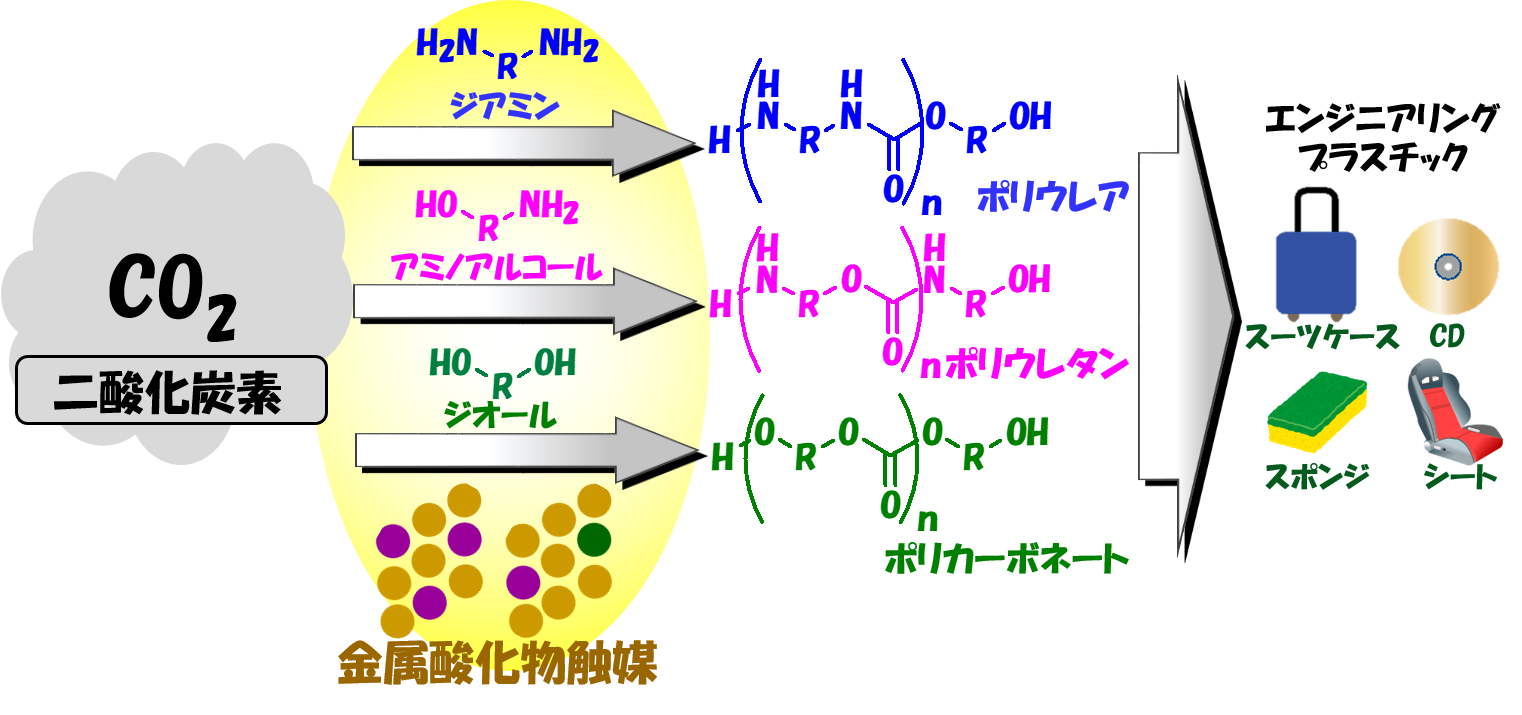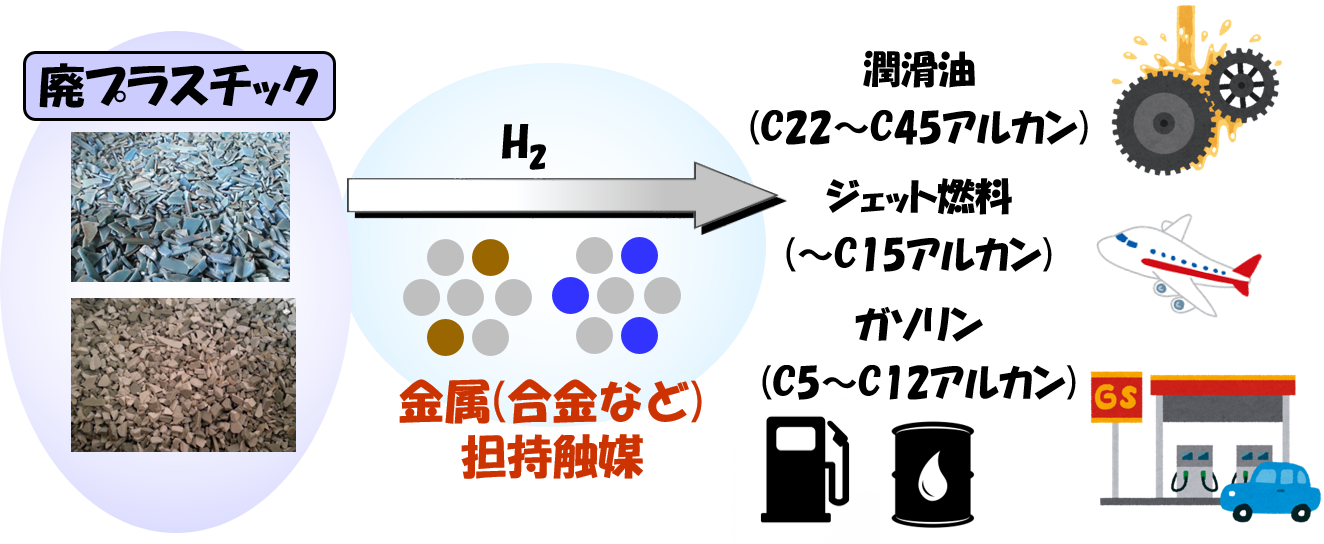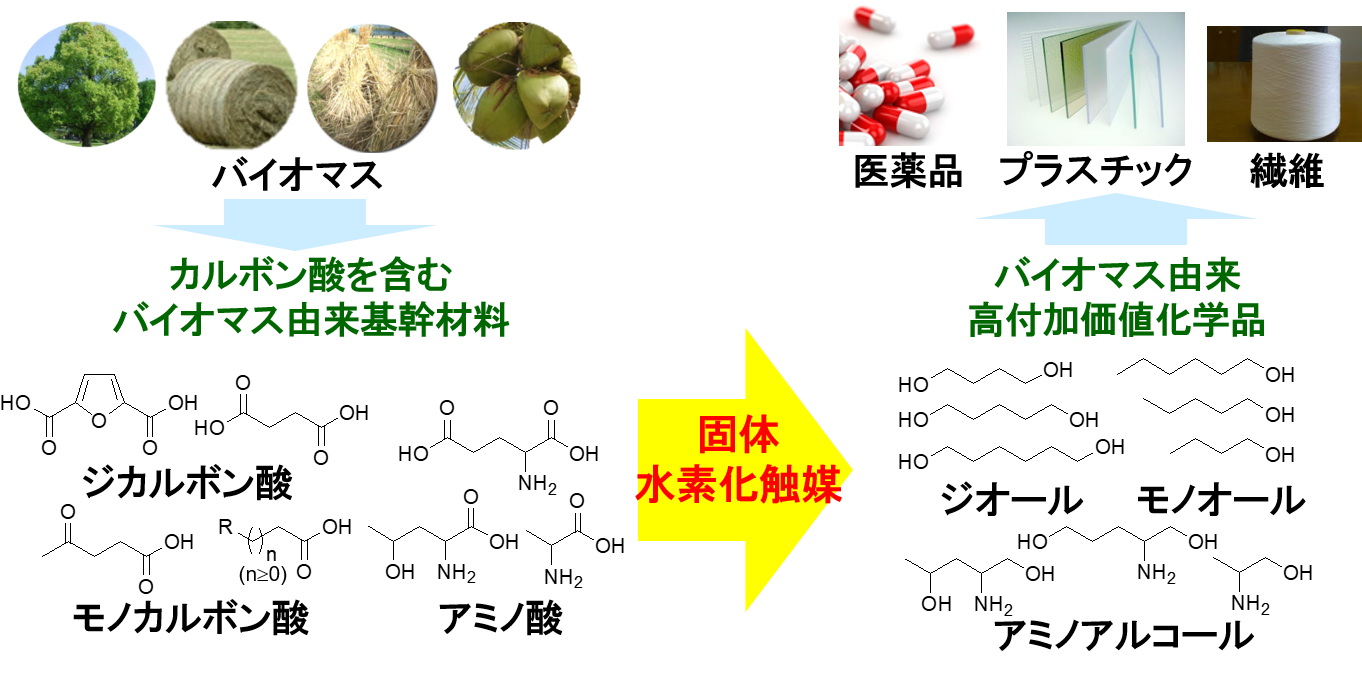Tamura Laboratory
The Tamura Laboratory belongs to the Catalytic Resource Conversion Division of the Artificial Photosynthesis Research Center of Osaka Metropolitan University
Resources such as carbon dioxide, plastics, and biomass require the development of new technologies that can effectively utilize these resources in view of environmental problems and oil depletion. The Tamura Laboratory aims to develop catalytic processes, especially solid catalytic processes, that can contribute to the recycling of these resources. We also aim to develop hybrid organic-inorganic catalysts as well as novel solid catalysts with precisely controlled active sites at the atomic level.
Development of solid catalysts for CO2 conversion
Various environmental problems have become apparent due to global warming. The development of technologies to reduce CO2, regarded as one of the main causes of these problems, is essential to realize a sustainable society. Our laboratory focuses on the non-reductive conversion of CO2 and aims to develop an effective solid catalyst process for this purpose.

Recent achievements
1) Adsorption behavior of atmospheric CO2 with/without water vapor on CeO2 surface, M. Akatsuka, A. Nakayama, M. Tamura, Applied Catalysis B: Environmental, 343 (2024) 123538.
2) Organic compound modification of CeO2 and 2-cyanopyridine hybrid catalyst in carbonate synthesis from CO2 and alcohols, M. Tamura, D. Hiwatashi, Y. Gu, A. Nakayama, Y. Nakagawa, K. Tomishige, J. CO2 Utilization, 54 (2021) 101744.
3) Hydrogen Atom Abstraction by Heterogeneous-Homogeneous Hybrid Catalyst of CeO2 and 2-Cyanopyridine via Redox of CeO2 for CH Bond Oxidation with Air, M. Tamura, E. Sagawa, A. Nakayama, Y. Nakagawa, K. Tomishige. ACS Catal., 11 (2021) 11867-11872.
Development of solid catalysts for plastic conversion
The reduction of plastic waste and its proper disposal is an issue on a global scale, such as the problem of marine pollution caused by plastics. Our laboratory aims to realize the chemical recycling of plastics, and aims to develop a solid catalyst process that enables the conversion of plastics into useful chemicals such as lubricating oil through chemical conversion.

Development of solid catalysts for highly difficult reduction reactions
The reduction reactions are the key reactions in biomass conversion, industrial chemistry, and the synthesis of fine chemicals. Therefore, the development of highly efficient and highly selective catalysts is desired. We aim to develop solid catalysts for reduction reactions that exhibit high activity and selectivity under mild conditions.

・Hydrogenation of carbonyl compounds (carboxylic acids, amino acids, amides, ketones, aldehydes, etc.)
1) Recent progress on the development of heterogeneous catalysts for hydrogenation of carboxylic acids to the corresponding alcohols. M. Tamura, Y. Nakagawa, Asian J.Org. Chem., 9 (2020) 126-143.
2) Recent Developments of Heterogeneous Catalysts for Selective Hydrogenation of Unsaturated Carbonyl Compounds to Unsaturated Alcohols, M. Tamura, Y. Nakagawa, K. Tomishige, J. Jpn. Petrol., (2019) 106- 119.
3) Selective hydrogenation of amides to alcohols in water solvent over a heterogeneous CeO2 -supported Ru catalyst, M. Tamura, S. Ishikawa, M. Betchaku, Y. Nakagawa, K. Tomishige , Chem. Commun., 54 (2018) 7503-7506.
・Reduction reaction of biomass
1) Direct Synthesis of Unsaturated Sugars from Methyl Glycosides, J. Cao, M. Tamura, Y. Nakagawa, K. Tomishige, ACS Catal., 9 (2019) 3725-3729.
2) Transformation of Sugars to Chiral Polyols over a Heterogeneous Catalyst, M. Tamura, N. Yuasa, J. Cao, Y. Nakagawa, K. Tomishige , Angew. Chem. Int. Ed., 57 (2018) 8058 -8062.
・Hydrogenationof unsaturated C=C bond
1) Bio-Based Cycloolefin Polymers: Carbonone-Derived Cyclic Conjugated Diene with Reactive exo-Methylene Group for Regioselective and Stereospecific Living Cationic Polymerization, T. Nishida, K. Satoh, S. Nagano, T. Seki, M Tamura, Y. Li , K. Tomishige , and M. Kamigaito, ACS Macro Lett., 9 (2020) 1178-1783.
2) Nickel-iridium alloy as an efficient heterogeneous catalyst for hydrogenation of olefins, J. Bai, M. Tamura, Y. Nakagawa, K. Tomishige, Chem. Commun., 55 (2019) 10519- 10522.
Heterogeneous catalyst systems with precisely controlled active sites (organic-inorganic hybrid catalysts, lone metal catalysts)
The design and development of catalysts that can achieve high activity and selectivity are essential for the development of industrial chemistry. Heterogeneous catalysts are suitable for industrialization, Therefore, more advanced catalyst designs are required. Our laboratory is aiming to develop a heterogeneous catalyst system with precisely controlled active sites on the metal oxide surface. In particular, we are developing organic-inorganic hybrid catalysts in which the surface of solid catalysts is modified with organic compounds and isolated metal catalysts.
Recent achievements
1) Self-Assembled Materials for Catalysis (Review), M. Tamura, Y. Nakagawa, K. Tomishige, Comprehensive Supramolecular Chemistry II, (2017) 329-349.
2) Formation of a New, Strongly Basic Nitrogen Anion by Metal Oxide Modification, M. Tamura, R. Kishi, A. Nakayama, Y. Nakagawa, J.-y. Hasegawa, K. Tomishige, J. Am. Chem. Soc., 139 (2017) 11857-11867.
3) Self-assembled hybrid metal oxide base catalysts prepared by simply mixing with organic modifiers, M. Tamura, R. Kishi, Y. Nakagawa, K. Tomishige, Nature Commun., 6 (2015) 8580.